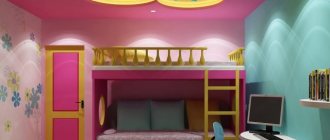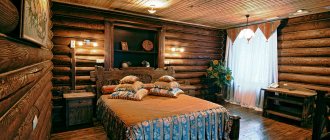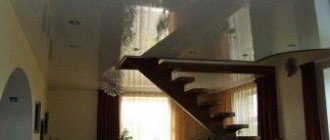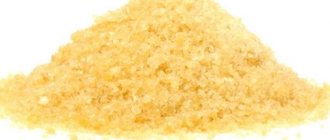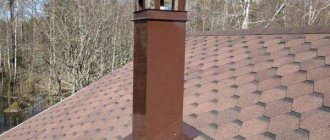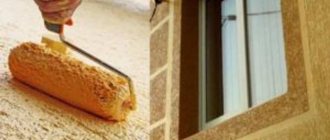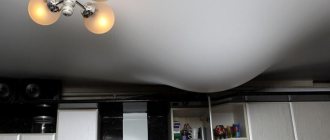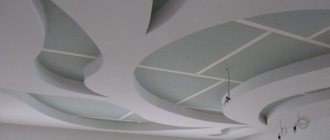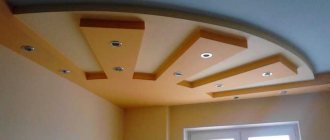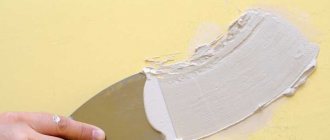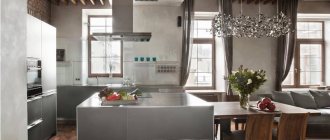Criteria for choosing ceiling finishes in a house or apartment
Practicality and aesthetic appeal are important parameters that the ceiling in a house or apartment must meet. In a cottage, it is also important to consider the location where renovations are planned. If this is a ceiling located directly under the roof slabs, then it needs to be insulated. If materials are selected for the first floor of a two-story house, then you can limit yourself to the same choice as for an apartment.
So, when considering different options, it is customary to take into account the following points:
- Room area . If the renovation is to be done in a large room, then slats and some types of suspended ceilings will not fit there. Just like narrow wallpaper. They prefer cladding, wide wallpaper and multi-level structures using plasterboard.
- Purpose of the premises . Wooden slats or panels, like fabric wallpaper or suspended ceilings, are not suitable for the bathroom and kitchen. But they can be used in the bedroom or hallway.
- Ceiling height . Multi-level structures are not used in apartments and houses with low ceilings. If the height is more than 2.7 m, then you can pay attention to suspended structures and solid stretch ceilings.
Finishing option in a room with a high ceiling Source design-homes.ru
- Room style . The gloss of the ceilings, the pattern of the plates and the wood of the slats are far from universal. For example, when arranging a loft, you can use hanging panels in a brutalist style, but glass, gloss and wood will not work here. Some wallpaper textures can also be an interesting solution.
- Price . The cheapest and simplest solutions would be plastic panels and wallpaper. Even those with little experience can handle their installation. But creating a luxurious suspended ceiling made of glass or a tension structure is a difficult task that only specialists can perform. And such ceiling finishing will cost significantly more.
It is very important to choose the right color scheme. So, the use of dark ceilings in most cases is a bad decision. But if the height in the house or apartment is 3 m or higher, then you can experiment.
Original ceiling and wall decoration with wallpaper Source guruotdelki.ru
Stretch ceiling assembly
We present a simple type of installation, when there are no pipes or other communications going through the ceiling, and the room has no protruding surfaces. To secure the film, a special profile is used - baguette.
The installation procedure is as follows:
- Using a water level, you need to find the lower level of the room. The mark is made by moving two centimeters, this is required for convenient fastening of the profile. Next you need to draw a zero level on all sides of the room.
- All corners in the room are measured to ensure smooth joining of the profile in the corners of the house. For this purpose, a folding protractor is used.
- It is necessary to prepare a profiling rail. When the slats are longer than the width of the room, then the ends of the slats are filed at an angle similar to half the angle of the room (measured with a protractor).
- When the rail is smaller than the width of the room, then the corner is sawed to the floor of the corner of the room, and the second at 90 degrees for a good fit to the second part of the profile.
- Then an additional section of the profile is taken and the same thing is done with it, only the bevel is made for a different angle. Two sections of the profile are coated with glue.
- The profile is mounted horizontally on the wall using dowels or self-tapping screws. As a result, you should end up with a room with a fixed profile on all sides of the ceiling.
A heat gun is connected to the work and the room should warm up to +40 degrees. Next, the canvas is tensioned.
Features of creating a ceiling on a loggia or in a private house
The optimal solution for the second floor or loggia is a suspended ceiling. It can be made from plasterboard, plastic or wooden lining. And between it and the ceiling they lay one of the insulation options:
- Mineral wool . Basalt is characterized by great resistance to water. Slag wool and glass wool are used in rooms that are well protected from moisture. All types of products perfectly dampen noise and vibration.
- Tile polystyrene . Inexpensive insulation with good moisture resistance. Easy to install and protects against heat loss. However, there is a significant drawback - toxicity and flammability. They are installed mainly in non-residential premises due to their low price.
- Foil mineral wool . It has increased protection against moisture, as well as improved heat reflection properties.
- Penoplex . A modern analogue of polystyrene foam, more elastic and dried.
On the loggia it is quite appropriate to use foam or penoplex options.
Soundproofing with mineral wool in an apartment Source build-experts.ru
Ceilings in the apartment and on the ground floor of the house
In areas where insulation is not required, there are many more options to choose from. Before deciding which ceiling is best for a particular case, you should learn about the pros and cons of existing solutions.
Option #1: using wallpaper
There is a huge amount of wallpaper that allows you to create coatings that, at first glance, are completely different from the usual finishing material. Non-woven, paper, liquid and even glass wallpapers are used for ceilings.
Important! This option can only be used on perfectly flat surfaces.
Among the advantages of this method is that repairs are easy to do yourself. There are other advantages:
- a huge selection of patterns and textures;
- low cost;
- installation speed - in just 1-2 days you can create a ceiling in all rooms;
- you can buy environmentally friendly, “breathable” wallpaper;
- The material creates coziness and increased comfort in the room.
However, there are also disadvantages, one of which is rapid fading in the sun when using bright ornaments. Wallpaper is also not suitable for rooms with high humidity. They also absorb odors, attract dust and quickly turn yellow from tobacco smoke.
Pasting bright wallpaper on the ceiling Source roomester.ru
See also: Catalog of companies that specialize in finishing materials and related work
Option No. 2: polystyrene foam boards
One of the most inexpensive, but obsolete options. The material for ceiling cladding is available in thicknesses up to 12-14 mm. The surface in most cases has a convex pattern.
Important! When choosing a material, carefully inspect the slabs. They should be smooth and straight on all sides. The tile must be strong: if you take it by the corner and easily lift it up and down, like a piece of paper, it should not break.
You can choose different color solutions - white, cream, with flowing pastel patterns. The advantages of the material include:
- minimum weight - only wallpaper is lighter;
- low cost;
- installation speed.
However, the ceiling cladding material has plenty of disadvantages:
- not an environmentally friendly material that can release harmful substances when heated;
- highly flammable, may crack and melt when installed in the kitchen;
- difficult care, high risk of damage;
- the tiles next to the chandelier and lamps quickly turn yellow;
- When the temperature changes, it begins to peel off.
Due to the porous structure, the slabs absorb odors, fats, and nicotine tars.
A man tries to scrub a ceiling made of polystyrene boards Source decoratorist.com
Option #3: using paints
Among the oldest and most famous methods of painting a ceiling is whitewashing with lime. However, the surface attracts dirt too much and may fall off in pieces.
When painting, a more careful approach to the choice of material is required. Also, puttying and priming must be used before applying paint. Water-based paint is often preferred due to its advantages:
- low cost;
- drying in 2-3 hours;
- environmental friendliness;
- the presence of substances in the composition that have an antiseptic effect;
- the possibility of obtaining different shades due to color schemes;
- easy application;
- high vapor permeability;
- UV resistance;
- good protection against attracting dirt.
It is important to consider that paint crystallizes at low temperatures. And not all compositions are suitable for use in the kitchen or bathroom. In rooms with high humidity, you can use acrylic water-based paint.
Fact! Plastic acrylic and silicone paints can mask cracks up to 1 mm deep!
There is also latex water-based paint that can be washed with soap and other means. However, latex is less resistant to fungus and ultraviolet radiation.
Frame installation
The hangers are attached with anchors; they do an excellent job of holding the suspended ceiling. Sealing tape is glued to the hangers. Having twisted the suspension, it is worth bending its edges so that they bend strongly;
Ceiling profiles are produced 3 m long; if the room is small, then they are cut with metal scissors 1 cm less than the length of the room. When the room is longer, you will need special connecting fasteners to increase the length of the guide;
Important information: When splicing a profile in length, connections of adjacent products are not allowed on a single line. Suspension is required near the joints;
To make a suspended ceiling, it is important to screw the profiles onto the hangers with self-tapping screws; work starts from the corners of the room. The second worker will take the profile and begin to support it so that it does not sag, at this time the first master will fasten it with 4 self-tapping screws and washers. The profiles are attached to the guides;
- The center of the profiles is fixed to the ceiling to the suspensions. Evenness should be checked using an extended level. After securing the hangers, the hanging edges are folded upward;
- Another profile is fixed in a similar way. Next you need to go to the other side and fix two rows of profiles there. Then comes the turn of the central profiles;
- Using crabs and self-tapping screws, jumpers are installed with a gap of 2.5 m. They are installed in the places where the joints pass between the plasterboard slabs;
- Now it's time to secure the drywall. The edges are cut with a knife until a small angle is formed. This is for better adhesion of the putty;
- The plates are screwed starting from the corner. The sheets are pressed against the profiles with a distance of 0.5 cm from the wall, and screwed in with self-tapping screws every 20 cm.
- The heads of the screws go slightly deeper into the plane of the gypsum board so that they do not stick out. The sheets are placed offset so that the 4 slabs do not converge in one place.
Video description
The video talks about the types and features of different water-based paints.
Option No. 4: finishing plaster
When choosing which ceiling is best to make, many people are faced with such a proposal as plastering. Modern materials make it possible to turn a once complex process into a relatively simple task. However, the ceiling will have to be carefully leveled, since decorative plaster is applied on top of a relatively smooth surface.
Among the advantages of plaster:
- speed and possibility of self-application;
- huge selection of colors and textures;
- environmental friendliness and resistance to sunlight;
- some compositions are not at all afraid of humidity - this is indicated on the packaging.
The cost of the material can vary greatly depending on its type and manufacturer.
Among the disadvantages, one can highlight the painstaking application process, since they are plastered in several layers. And each one must be completely dry before applying the next one.
Installation of panels
The panels are attached to the aluminum profiles located along all the walls and to the wooden blocks, which are also suitable for the frame, with self-tapping screws or staples using a stapler.
Before this, the panels are cut to the required sizes. They fit into each other well using the tongue/groove method.
- The first plank is installed with the ridge against the wall so that the next part can be inserted into the groove.
- At the top end there is a place for screwing in a self-tapping screw.
- So all the parts are gradually laid out and secured.
- A small gap is left for the last part for its insertion into the structure.
- All this work on making ceilings can be done independently.
Each type of ceiling has its own strengths and weaknesses.
Which ceiling to choose and implement must be decided by each family individually, taking into account their wishes and financial capabilities.
Video description
The video presents many interesting solutions for decorating a house, apartment, office and other premises.
Another option is continuous sheathing, for which plasterboard is used. The technique is used to level the ceiling, as well as to install insulation between the decorative material and the sheathing. This method can be used, for example, to soundproof an apartment. Install drywall onto the sheathing. Among the advantages of creating such a “second” ceiling is the ability to remove all communications into this structure.
Option No. 6: using suspended ceilings
Among the methods of ceiling finishing, tension structures occupy an important place. Their most significant drawback is their high cost, since you cannot stretch the film yourself.
Option for combining matte and glossy stretch ceilings Source iceceiling.com.tr
Suspended structures
The proposed videos of do-it-yourself ceiling repairs make it possible to visually assess the complexity of the work being carried out.
Thanks to the video material, you can independently carry out repairs and install suspended structures for further securing plasterboard, PVC panels, and other finishing materials.
Comparison of different finishing methods
Use this handy cheat sheet on ceiling arrangement options when considering a renovation:
| View | Difficulty of care | Where not to use | Water resistance | Difficulty of installation |
| Water-based paint | Average | Bathroom and kitchen | Bad | Very simple |
| Wallpaper | Just | Kitchen and bathroom, unless it is a special type of waterproof wallpaper | Bad if it's not washable wallpaper | Just |
| Liquid wallpaper | Just | Bathroom, kitchen | No | Average |
| PVC panels | Just | Bathhouse, unheated premises | + | Depends on technology |
| Decorative plaster | Just | You can choose an option for any room | + | Average |
| PVC stretch ceiling | Just | Unheated premises | + | Difficult |
| Fabric stretch ceiling | Difficult | Bathroom, kitchen | No | Difficult |
| Plasterboard solid ceiling | Difficult | There are moisture-resistant options for all rooms | + | Average |
| Foam tiles | Just | Bathroom, toilet | Will last less than other options | Just |
| Metal slats | Just | — | + | Average |
| Wood slats | Average | Bathroom and toilet | No | Average |
| Glass or mirrors | Average | — | + | Difficult |
If the choice fell on natural materials such as cork, then you will have to take into account the difficulty of caring for them. Most of them are not suitable for installation in the kitchen and bathroom.
Tool for the job
To carry out preparatory work with your own hands, you should take care of the following tool in advance:
- perforator;
- electric drill;
- screwdriver;
- Bulgarian;
- grinding machine or mesh;
- spatulas with a width of 25, 50, 100 and 150 mm;
- Master OK;
- rule;
- paint roller;
- paint brush;
- screwdriver;
- chisel;
- chisel.
You should prepare containers for preparing (mixing) solutions and delivering them to the ceiling, convenient for work. Measurements and quality control are provided with a tape measure, a metal ruler, and a building level. A laser type level is best. We should not forget about protective measures - glasses, gloves, a respirator when grinding.
Briefly about the main thing
So, when choosing the type of ceiling decoration, we focus not only on the cost of the materials, but also on their suitability for a particular room. It is important to evaluate all the pros and cons of existing options.
One of the parameters is the repair work area. Insulation can be used on the loggia and on the floor of a private house that borders the roof. And make the ceiling itself suspended - from plasterboard or lining.
In an apartment, attention is often paid to such coatings as:
- stretch ceiling;
- wallpaper;
- metal and wooden slats;
- covering with suspended panels, including glass;
- coloring;
- applying plaster.
While painting, wallpapering, and even installing slats are relatively simple tasks, installing modular wall-mounted or glass structures will require some work. But polystyrene ceiling tiles are a thing of the past.
Ratings 0
Ceiling made of PVC panels
Some people are interested in: how to decorate the ceiling with plastic panels? First you need to install the frame. Using dowels, fasteners should be screwed on all sides of the room into which parts will need to be inserted across the width.
Sometimes a special plastic profile is suitable for this, with which you can install it quickly. Next you will need to secure the frame cross members. They allow you to strengthen the panels in the central part. In small rooms they may not be practical.
